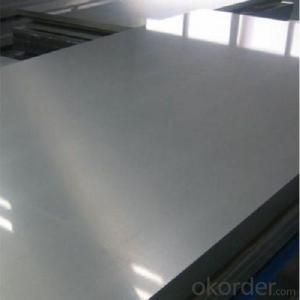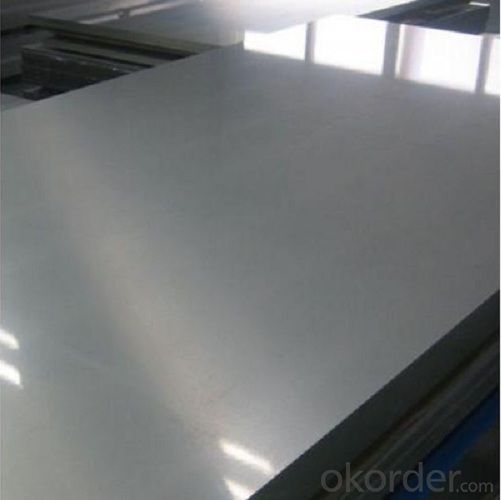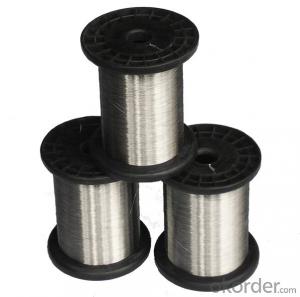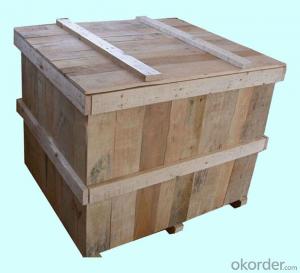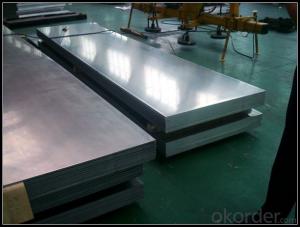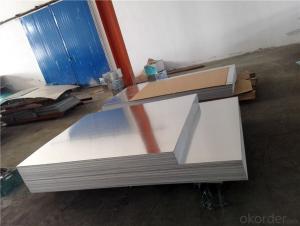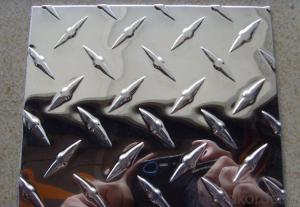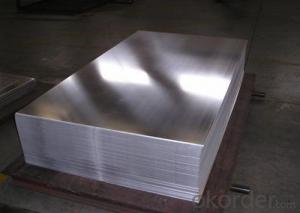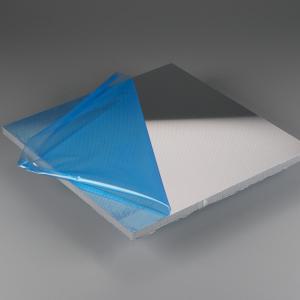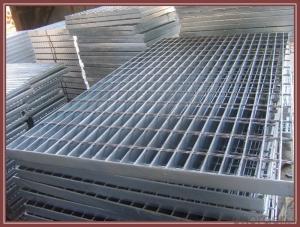Factory Direct Supply Aluminum Sheets Vancouver BC Free Size
- Loading Port:
- Shanghai
- Payment Terms:
- TT OR LC
- Min Order Qty:
- 5 m.t.
- Supply Capability:
- 5000 m.t./month
OKorder Service Pledge
OKorder Financial Service
You Might Also Like
Specification of aluminium sheet:
Alloy | Temper | Thickness | Width |
3105,3005,3104,3004,3003,3103 5052,5754,5083,5005 1050,1060,1070,1100,1200 |
H12,H14,H18,H22,H122 |
0.5-1650mm |
100-1650mm |
Aluminium sheet application:
1.cookware, automotive and lighting industries.
2.Low anisotropy, which facilitates deep drawing.
3.Strong mechanical properties. And moreover, the aluminium sheet price is competitive.
Packaging & Delivery
Packaging Details: 1 EPE:protect aluminium.
2 Plastic sheet:water-proof.
3 Carton:anti-shock. 4 Steel bar:fix Delivery Detail: 25 days after the advance payment by T/T or L/C

FAQ
Q: Do you provide free samples?
A: Yes, free samples will be sent to you on freight at destination.
Q: Can I get your latest products catalogue?
A: Yes, it will be sent to you in no time.
Q: What is the MOQ?
A: 5 tons
Q: What are your payment terms?
A: We accept L/C, T/T.
- Q: could aluminum sheet be attracted by magnet?
- no, it couldn't.
- Q: What are the different methods of forming aluminum sheets?
- Aluminum sheets can be formed using various methods, each with its own set of advantages and applications. Below are some examples of these methods: 1. Rolling: The most commonly used method for forming aluminum sheets is rolling. This involves passing a large aluminum ingot through a series of rolling mills, gradually reducing its thickness and increasing its length. The ingot is rolled multiple times until the desired thickness is achieved. Rolling is versatile, as it can produce aluminum sheets of different thicknesses and widths to suit various applications. 2. Extrusion: Another method used for forming aluminum sheets, particularly for complex cross-sectional profiles, is extrusion. In this process, a heated aluminum billet is forced through a shaped die, resulting in a continuous length of aluminum with the desired shape. Extrusion allows for the creation of intricate designs and is commonly employed in the production of structural components and frames. 3. Casting: Casting is a method used to form aluminum sheets with a specific shape or pattern. Molten aluminum is poured into a mold and left to cool and solidify. The mold can be made of different materials, depending on the complexity of the desired shape. Casting is often used for decorative purposes and in the production of architectural panels. 4. Stretch forming: Stretch forming is a specialized method used to form aluminum sheets into curved or contoured shapes. The sheet is clamped at its edges and stretched over a form using hydraulic or mechanical forces. As the sheet is stretched, it takes on the shape of the form, resulting in a curved or contoured sheet. Stretch forming is commonly utilized in the aerospace and automotive industries for components like fuselage sections and car body panels. 5. Pressing: Pressing, also known as stamping or punching, is a method employed to form aluminum sheets into specific shapes or patterns. The sheet is positioned between a die and a punch, and pressure is applied to deform the sheet. The die and punch can have various designs, allowing for the creation of simple cutouts or intricate patterns. Pressing is frequently employed in the manufacturing of automotive parts, appliances, and electronic enclosures. These are just a few examples of the various methods used to form aluminum sheets. Each method offers distinct advantages and is chosen based on the specific requirements of the desired shape, thickness, and application of the aluminum sheet.
- Q: How does the reflective film stick to the aluminum plate?
- Put the plate clean, dry, reflective film a head from the aluminum back 2CM at the beginning attached to the aluminum plate, wrapping, pull to the front, back and side brush paper hanging tear reflective film side with the hanging brush to the aluminum paste, try to avoid bubbles.
- Q: Can aluminum sheets be used for architectural facades?
- Yes, aluminum sheets can be used for architectural facades. Aluminum is a versatile material that offers several advantages for facade applications. It is lightweight, durable, and corrosion-resistant, making it suitable for various weather conditions. Aluminum sheets can be easily fabricated and installed, offering flexibility in design and allowing for intricate and complex facades. Additionally, aluminum can be finished in a variety of ways, including powder coating, anodizing, or painting, to enhance its appearance and provide the desired aesthetic appeal. Overall, the use of aluminum sheets for architectural facades provides architects and designers with a wide range of options to create visually appealing and long-lasting building exteriors.
- Q: What characteristics distinguish aluminum sheets from other types of sheets?
- <p>Aluminum sheets are lightweight, corrosion-resistant, and have excellent thermal and electrical conductivity. They are commonly used in construction, automotive, and packaging industries. In contrast, other types of sheets, such as steel sheets, are heavier and stronger but less resistant to corrosion. Plastic sheets are lightweight and flexible but have lower strength and thermal conductivity. Copper sheets offer high thermal and electrical conductivity but are more expensive and less resistant to corrosion than aluminum. Each type of sheet has unique properties that make it suitable for specific applications.</p>
- Q: Are aluminum sheets suitable for food processing applications?
- Yes, aluminum sheets are suitable for food processing applications. Aluminum is known for its excellent thermal conductivity and corrosion resistance, making it ideal for food industry processes such as cooking, baking, and packaging. Additionally, aluminum is a lightweight and cost-effective material that can be easily formed into various shapes and sizes, making it convenient for food processing equipment and utensils.
- Q: How strong is aluminum per square inch, and at the same time how light is the aluminum per square inch?
- we have large aluminium sliding doors and in the summer time they twist and will not open why is this.
- Q: Can aluminum sheets be used for heat sinks in LED lighting?
- Indeed, heat sinks in LED lighting can utilize aluminum sheets. Aluminum possesses remarkable heat conductivity, which renders it a perfect substance for dispersing the heat emitted by LED lights. By employing aluminum sheets as heat sinks, the heat generated by the LED chips is effectively transferred away, thereby averting overheating and extending the lifespan of the LED lighting system. Furthermore, aluminum's lightweight nature, resistance to corrosion, and affordability further contribute to its widespread adoption as a heat sink material in LED lighting.
- Q: I am ultimately looking to have a bike that is good for both everday commuting and touring with panniers/racks long distance with camping. From what I've read on the internet steel frames are more forgiving and ride smoother. The guy at my local bike shop tells me aluminum frames have more flex and ride better. I don't know if he's just trying to make a sale (Giant dealer) or to trust him, unfortunately the staff there are all just racers not tourers. If you can recommend any brands/models to check out that'd be good. From my research thus far I am in love with Co Motion bikes, just not the price! I'm looking at $1000 max for a good touring bike. Thanks!
- I've owned a few different bikes-- Aluminum (light but very stiff), steel (slightly heavier but far more comfortable) and Carbon Fiber (high end racing bike, extremely comfortable ride and very light). For touring and commuting I don't use the racing bike-- steel all the way. Plus, you can find great steel frames that are built for touring (surly has some great frames that I love) with attachments for all of the add-ons you'd want. At the point where you are touring you are carrying so much extra weight (panniers, bags, spare parts, etc) that an extra 5 pounds of frame weight is negligible.
- Q: What is the corrosion resistance of aluminum sheets?
- Aluminum sheets possess remarkable resistance to corrosion. When exposed to oxygen, aluminum automatically develops a protective oxide layer on its surface, functioning as a barrier against corrosion. This layer is extremely stable and effectively halts any further oxidation of the metal, resulting in aluminum's exceptional resistance to corrosion in nearly all surroundings. Furthermore, aluminum sheets can be improved even further through surface treatments or coatings to augment their corrosion resistance. As a result, aluminum sheets are widely favored for a multitude of applications in which corrosion resistance is of utmost importance, including the construction industry, automotive manufacturing, and marine applications.
Send your message to us
Factory Direct Supply Aluminum Sheets Vancouver BC Free Size
- Loading Port:
- Shanghai
- Payment Terms:
- TT OR LC
- Min Order Qty:
- 5 m.t.
- Supply Capability:
- 5000 m.t./month
OKorder Service Pledge
OKorder Financial Service
Similar products
Hot products
Hot Searches
Related keywords
